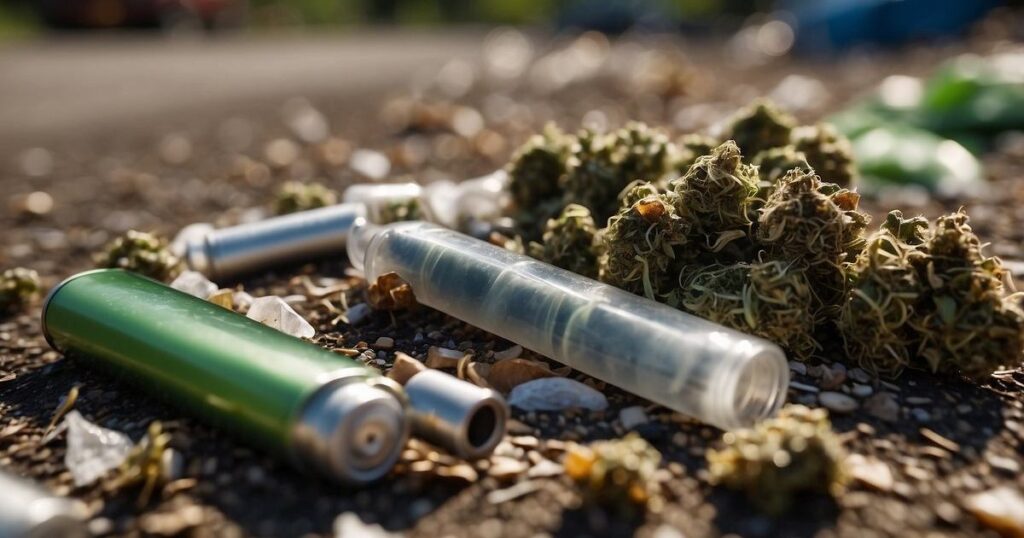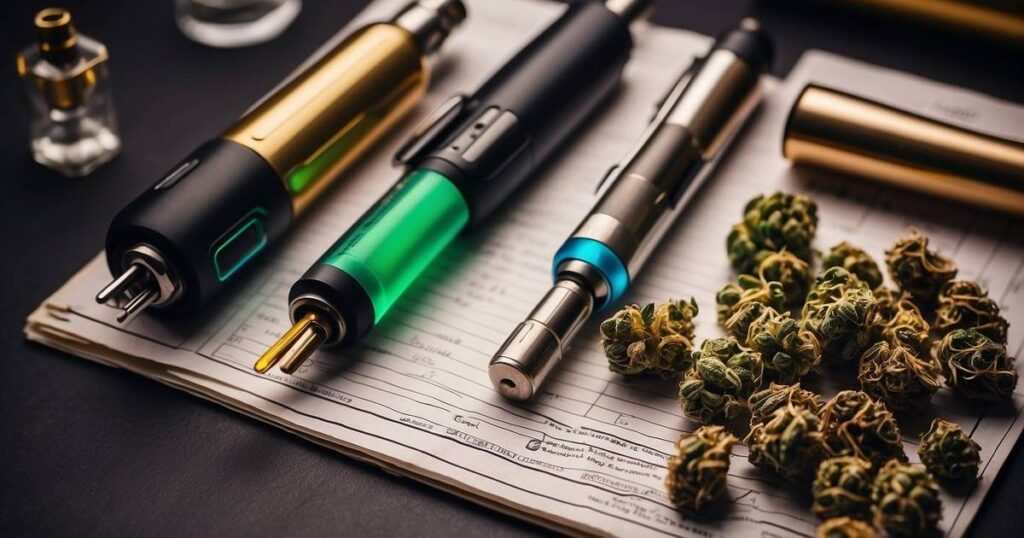Impact of Disposable Cannabis Vapes on Health: A Comprehensive Analysis
Impact of Disposable Cannabis Vapes on Health: A Comprehensive Analysis
The use of disposable cannabis vapes has become a popular method of consumption, particularly for its convenience and discretion. As this trend continues to grow, you need to understand the possible health impact of disposable cannabis vapes. While vaping cannabis can have certain perceived benefits over traditional smoking, such as a reduced presence of combustible toxins, it is crucial to consider the health risks involved as well. Preliminary studies suggest that the heating elements in some disposable vapes may not be reliable, potentially leading to the release of harmful chemicals.
Moreover, the health impact of disposable cannabis vapes extends beyond the risk of faulty heating elements. The increase in their use has highlighted a concern for lung health, with incidents of vaping-associated lung injuries drawing attention to the safety of inhaling aerosolized cannabinoids. As a consumer, being aware of these potential health risks, including the development of EVALI (e-cigarette and vaping-associated lung injury), is vital in making informed choices about cannabis consumption.
Key Takeaways
- Disposable cannabis vapes pose both potential health benefits and risks.
- It’s essential to be aware of the health impact of disposable cannabis vapes on lung health.
- Understanding the safety and regulation of vaping devices can inform safer consumption choices.
Health Risks and Effects of Disposable Cannabis Vapes
Disposable cannabis vapes are a convenient option for consuming marijuana, but there are various health risks and effects you should be aware of.
Evaluation of Chemicals and Potential Toxins
Disposable vape products may contain an array of chemicals and potential toxins. These include heavy metals like lead, which can leach from the vape’s heating elements into the aerosol you inhale. Additionally, the cartridge may release carcinogens if the vape overheats the cannabis oil.
Physical Health Consequences
You may experience throat irritation or lung damage from the inhalation of aerosol, which contains fine particles and other byproducts of vaping. Cases of acute lung injury, termed EVALI, have been linked to certain substances inhaled via vapes.
Mental Health Considerations
Vaping marijuana can lead to mental health effects such as heightened anxiety or exacerbate an existing substance use disorder. The e-liquid’s potency level and your health play roles in these outcomes.
Public Health and Youth Exposure
Youth and adolescents are especially at risk as vaping marijuana can impact brain development. A surge in e-cigarette use among teenagers correlates with increased cannabis use and exposure to potential nicotine addiction.
Incidents and Medical Cases
Reports of hospitalizations due to lung diseases associated with vaping cannabis indicate significant health risks. Notable incidents include severe lung disease and even death in extreme cases linked with contaminated or poorly regulated products.
Regulation and Quality Control
Vape pens and related products often fall into a grey area in terms of regulation. Due to this lack of oversight from bodies like the FDA, illegal or unregulated vape pens may be more harmful due to the absence of quality control.
Long-Term Health Effects
The long-term health impact of disposable cannabis vapes remains uncertain, with researchers considering their potential to cause chronic problems such as cancer or other serious conditions.
Comparative Risks: Vaping vs. Smoking
Vaping marijuana may introduce fewer smoke-related toxins into your body compared to smoking traditional cigarettes. Still, it’s not without its suite of health risks, many of which overlap with those attributed to tobacco.
Vaping Technology and Usage Patterns
The technology of disposable vapes, including their voltage and heating elements, affects how substances are inhaled. Intense heat can decompose THC and other cannabinoids, creating potentially harmful byproducts.
Consumer Awareness and Misconceptions
There’s a misconception that vaping cannabis is completely safe. Being informed about symptoms like pain, inflammation, or injury associated with vaping can help you make safer choices regarding the health impact of disposable cannabis vapes.
Substance Use and Dependency
Regular use of disposable cannabis vapes may lead to addiction or a substance use disorder, especially since they allow for the discreet and persistent use of high-potency cannabis oil, which might lead to increased tolerance and dependency.
Environmental and Sustainability Challenges
In addressing the health impact of disposable cannabis vapes, you must not overlook the significant environmental concerns they pose.
Waste and Disposal Issues
Your use of disposable vape pens contributes to a larger waste problem, as most devices end up in landfills. The materials used in cartridges and the pens themselves are not biodegradable, which means they persist in the environment for extended periods, potentially leading to soil and water contamination.
Battery and Hardware Concerns
The batteries in disposable cannabis vapes are often the lithium-ion type, which poses risks if not disposed of properly. Damage to these batteries can result in hazardous chemicals leaking into the environment. Moreover, the hardware’s mixed composition makes recycling complicated.
Manufacturing and Life Cycle Analysis
From production to disposal, the life cycle of disposable vapes negatively impacts various environmental facets. Energy-intensive manufacturing processes and the resource extraction required for the electronic components contribute to a significant ecological footprint.
Policy and Regulation for Environmental Safety
There are currently limited regulations specifically guiding the environmental policy of disposable vape production and disposal. This lack of policy hampers the establishment of effective recycling schemes and proper waste management practices, which are crucial for protecting public health and the environment.
Consumer Responsibility and Product Alternatives
You have the power to influence this situation by opting for products with sustainable practices. The market offers alternative products that minimize environmental impact. By choosing refillable vapes over disposable ones and supporting appropriate recycling programs, you take an active role in reducing the environmental effects of vaping.
As a consumer, being aware of the cannabis vape and health discourse means recognizing the dual importance of personal health and environmental sustainability.
Frequently Asked Questions
Before you decide against the use of disposable cannabis vaporizers, it’s essential to understand the health implications. This section addresses common concerns and provides informed answers based on current knowledge.
What are the potential health risks associated with using disposable cannabis vaporizers?
The health impact of disposable cannabis vapes can include lung irritation and potential damage from inhaling chemicals released by overheated oils. Some vapes may contain contaminants or compounds like vitamin E acetate, which have been linked to lung injury.
Can excessive use of disposable cannabis vapes lead to side effects, and if so, what are they?
Yes, excessive use of cannabis vape products may lead to side effects such as coughing, chest pain, and shortness of breath. Extended use has also been associated with an increased risk of developing chronic respiratory issues.
Is there a difference in health impact between vaping cannabis and smoking it?
Vaping cannabis is often perceived as a less harmful alternative to smoking because it typically involves lower temperatures that don’t produce smoke. However, both methods can expose your lungs to harmful substances, although the specific health impacts might differ.
What symptoms might indicate lung damage from the use of disposable cannabis vapes?
Symptoms of lung damage from vaping can include difficulty breathing, persistent coughing, chest pain, and sometimes nausea or fever. Any of these should prompt an immediate consultation with a healthcare provider.
Are there any health benefits linked to using a dry herb vaporizer for cannabis consumption?
Dry herb vaporizers may reduce the inhalation of combusted material, potentially mitigating some respiratory risks. However, the health benefits need to be better established, and any form of inhalation carries some risk.
How does the use of CBD in vaping devices affect respiratory health?
CBD in vaping devices is gaining popularity, but research on its long-term effect on respiratory health is limited. While CBD itself isn’t typically harmful, the other ingredients in the vape solution and the device’s heating mechanism can impact lung health.
Legality of Disposable Cannabis Vapes: Understanding Regulatory Status
Legality of Disposable Cannabis Vapes: Understanding Regulatory Status
The legality of disposable cannabis vapes varies significantly across jurisdictions, making it crucial for you, as a consumer or industry participant, to understand the specific laws and regulations about cannabis vape pens in your region. While some areas have fully legalized cannabis for medical or recreational use, others maintain strict prohibitions, leaving disposable cannabis vapes in a legally grey area. Navigating these regulations is essential, as it determines the availability and legality of these products.
In the shifting landscape of cannabis vape laws, understanding the regulatory environment is just the beginning. Beyond legality, there are environmental and health considerations that you may weigh when choosing to use disposable cannabis vapes. Issues such as the potential health implications of vaping and the ecological impact of disposable vapes are increasingly at the forefront of consumer concerns, influencing both personal choices and the broader regulatory discussions shaping the industry.
Key Takeaways
- Regulatory frameworks for disposable cannabis vapes differ widely.
- Health implications and environmental impact influence consumer use.
- Staying informed on vaping laws ensures compliance and safety.
Legality and Regulations
Understanding the legality of disposable cannabis vapes is crucial, given the patchwork of laws that vary by jurisdiction. It is your responsibility to know the regulations in your area.
State-by-State Legal Status
Your ability to legally purchase and use disposable cannabis vapes depends on your location’s specific laws. States such as California, Colorado, Nevada, Washington, New Jersey, Massachusetts, Michigan, Maine, Illinois, and Montana have legalized cannabis for recreational use, which typically includes disposable vapes. Conversely, states like North Carolina, South Dakota, Pennsylvania, Wisconsin, and Virginia have varying degrees of restrictions, with some only allowing medical use and others banning cannabis entirely.
- Legal States:
- Recreational: California, Colorado, Nevada, New Jersey, Arizona, New York, etc.
- Medical: Montana, New Mexico, Arizona, etc.
- CBD only: States like Wyoming and Iowa.
- Fully illegal: States such as Idaho.
Federal Law vs. State Legislation
At the federal level, cannabis is still classified as a Schedule I controlled substance. This classification conflicts with state legislation, where cannabis has been legalized for either medical or recreational use. Despite federal regulations, states like Colorado and Washington led the way in defying federal law by legalizing the recreational cannabis market, including disposable vapes.
- Federal Laws:
- Controlled Substances Act: Lists cannabis as Schedule I.
- State Compliance: Mandatory even in states with legal markets.
Disposable Vape Regulations
Local authorities and state legislation have the power to dictate the specific regulations concerning the use and disposal of disposable cannabis vapes. For instance, California has passed laws to ensure proper disposal of vape pens, targeting environmental impacts. In contrast, New Jersey’s current legislation is under scrutiny and may require updates to accommodate the growing legal market.
- California: A.B. 1894 prohibits marketing disposable vapes as easily discardable.
- Colorado: Has specific regulations on how and where you can use cannabis vapes.
- New Jersey: Calls for updated regulations to address safety and quality in the legal market.
Environmental and Health Considerations
When exploring the legality of disposable cannabis vapes, you must consider the environmental impact and health challenges they pose. These factors influence regulatory measures and compliance with quality and safety standards.
Environmental Impact
Disposable cannabis vapes contribute to environmental concerns primarily due to their material composition and poor recyclability. The high turnover rate of these devices generates considerable waste:
- Lithium-ion Batteries: Most disposable vapes contain lithium-ion batteries, which, if not disposed of properly, can become hazardous waste.
- Materials: The plastics and metals used are not biodegradable and are difficult to recycle due to THC residue.
- Recycling Challenges: There currently needs to be a standardized legal recycling process for disposable vapes.
Health and Safety Concerns
You should be aware of the health and safety concerns related to the use of disposable cannabis vapes:
- Inhalation Risks: Inhaling vapor can introduce harmful substances to your lungs, potentially causing damage. THC can impact cognitive and motor skills, while some vapes may contain nicotine, an addictive substance.
- EVALI: The emergence of e-cigarette or vaping product use-associated lung injury (EVALI) underscores the critical nature of product safety.
- Risk of Explosion: Poor quality vapes may have a risk of exploding due to faulty lithium-ion batteries.
Quality and Safety Standards
Compliance with quality and safety standards is non-negotiable to ensure your safety:
- Safety: To safely consume medical cannabis, vapes must meet strict quality control measures.
- Quality Compliance: The cannabinoid content, particularly THC levels in vapes, must align with regulatory compliance to ensure you’re informed of the product’s potency.
- Research and Development: Continuous research is necessary to develop safer vaping devices and disposables that minimize health risks and environmental burdens.
The legality of disposable cannabis vapes is evolving, with specific laws governing their sale, distribution, and use varying by region. You need to stay informed about the cannabis vape laws in your area to ensure compliance and awareness of any health advisories or recycling programs.
Frequently Asked Questions
The legality of disposable cannabis vapes varies depending on state regulations and specific laws within each state. You should consult local laws and regulations for accurate and relevant legal advice.
What are the current legal regulations surrounding disposable cannabis vapes in the USA?
In the United States, cannabis is federally illegal; however, several states have enacted laws permitting the use of cannabis, including disposable vapes, for recreational or medicinal purposes. Each state has its own set of regulations you must comply with.
Are there any specific laws about the use of wax pens in California?
California allows the legal use of cannabis products, including wax pens, for adults aged 21 and older. You are required to purchase these products from licensed dispensaries.
How does the legality of dab pens vary between states like Ohio and Tennessee?
Ohio permits the use of cannabis and dab pens for medical purposes with a valid recommendation from a physician. Contrarily, Tennessee has strict laws where any form of cannabis is illegal except for certain limited medical CBD products.
Is it legal to carry a disposable cannabis vape in public places?
The legality of carrying disposable cannabis vapes in public places depends on the state’s cannabis vape laws. Many states that have legalized cannabis have restrictions on public consumption.
Can disposable CBD vapes be legally purchased and used?
Disposable CBD vapes that contain less than 0.3% THC are legal on the federal level due to the 2018 Farm Bill. However, some states have specific laws regarding the sale and use of CBD products that you must review before purchasing.
What are the regulations for mailing disposable vapes like puff bars?
Mailing disposable vapes like puff bars are regulated by federal law and the U.S. Postal Service policies. Since the passage of the PACT Act, there have been strict limitations and regulations on mailing vaping products, including the requirement that senders and receivers be registered and comply with all shipping and labeling rules.
Different Types of Disposable Cannabis Vapes: Your Guide to Choosing the Right One
Different Types of Disposable Cannabis Vapes: Your Guide to Choosing the Right One
Disposable cannabis vapes have revolutionized the convenience of enjoying cannabis. They are pre-filled devices ready to use right out of the box, offering a hassle-free experience. These single-use vaporizers cater to various preferences, each providing a distinct experience tailored to your needs. The market has witnessed a surge in different kinds of disposable cannabis vapes, ensuring there is a convenient option for both new and seasoned users.
At its core, the primary appeal of a disposable cannabis vape lies in its simplicity and ease of use. Unlike their rechargeable counterparts, these vapes are designed to be discarded after the contained cannabis concentrate is depleted. Vape pens come loaded with a range of cannabis concentrates, from oils to live resins, each offering a unique potency and flavor profile. The diversity of the product lineup ensures a match for the discerning tastes of a wide user base, as well as practical considerations around portability and discreetness.
Key Takeaways
- Disposable cannabis vapes offer unmatched convenience for on-the-go consumption.
- Vape pens are available with various types of cannabis concentrates to suit individual preferences.
- Consider ease of use, potency, and flavor variety when selecting a disposable vape pen.
Understanding Disposable Cannabis Vapes
In exploring the realm of disposable cannabis vapes, you’ll encounter a vast array of components, concentrate types, and potency levels. These key points equip you to distinguish between different types and make informed choices based on your preferences.
Components and Functionality
Your disposable cannabis vape is composed of several key elements that work together to deliver vapor. At the core is the battery, which powers the heating element or atomizer. Surrounding the atomizer is a wick, typically made of cotton, that draws in the cannabis concentrate. The cartridge or reservoir houses the concentrate, while the mouthpiece is where you inhale the vaporized product. These vapes are designed conveniently and portably, often using a 510 thread for standard cartridge compatibility.
- Battery: The power source for the heating element.
- Heating Element/Atomizer: Heats the concentrate to create vapor.
- Wick: Absorbs the concentrate and brings it to the heating element.
- Cartridge/Reservoir: Contains the cannabis concentrate.
- Mouthpiece: The point of inhalation.
Types of Concentrates Used
Disposable cannabis vapes can utilize a diverse range of concentrates. From distillate and full-spectrum extract to live resin, wax, shatter, and diamonds, each type of concentrate offers distinct flavors, experiences, and potency levels. They are rich in cannabinoids such as THC, CBD, and terpenes, providing unique aromas and benefits. Your experience can vary greatly depending on the concentrate used, with options for high and low-potency products.
- Distillate: A highly purified form of cannabis oil, often potent in THC or CBD.
- Full-spectrum extract: Contains the full range of cannabinoids and terpenes found in the cannabis plant.
- Live Resin: Extracted from fresh, flash-frozen cannabis to preserve terpene profiles.
- Wax/Shatter/Diamonds: Different textures and forms of concentrates offer various levels of potency and flavor profiles.
Varieties and Potency
Within the types of disposable cannabis vapes, you’ll find a variety catering to indica, sativa, and hybrid strains, each with different effects attributed to the unique profiles of active cannabinoids and terpenes. The concentration of active cannabinoids like THC and CBD predominantly determines the potency. Cannabis vape varieties range from oils that provide a mild experience to high-potency extracts such as distillates and live resins, which offer more intense effects.
- Indica: Typically associated with full-body relaxation.
- Sativa: Often linked with uplifting and energetic effects.
- Hybrid: A balance of indica and sativa characteristics.
- Potency: Dictated by the levels of cannabinoids, particularly THC, which can vary from mild to extremely potent.
Benefits and Considerations of Disposable Vapes
As you navigate the world of disposable vape pens, carefully weigh their benefits and considerations. With user-friendliness and maintenance, portability, health and safety, as well as quality and pricing at stake, your choice will significantly impact your cannabis vaping experience.
Ease of Use and Maintenance
Disposable cannabis vapes, such as pre-filled disposable carts or all-in-one vaporizers, are designed for user convenience. With no maintenance required, these devices are ready to use right out of the package, and there’s no need to clean or replace any parts. They operate on a simple inhale-to-activate mechanism, which makes them an attractive choice for both new and experienced cannabis users.
Portability and Discreetness
The sleek design of disposable weed vapes makes them easily portable, fitting in your pocket or purse without hassle. They are also notably discreet, with minimal odor release compared to traditional smoking methods. This discretion makes disposable vapes suitable for those who prioritize privacy in their cannabis consumption.
Health and Safety
While health and safety are paramount, disposable vapes are often perceived as a healthier alternative to smoking, as they don’t involve combustion and thus reduce exposure to carcinogens. However, there is a concern about the potential exposure to harmful chemicals if the vape pen overheats. Always patronize a reputable brand that ensures product safety and compliance with regulations.
Quality and Pricing
Quality and price vary across types of disposable cannabis vapes. Binoid and other trusted brands offer high-quality devices known for consistent and flavorful vapor production. On average, disposable vapes may seem cost-effective, but the price tag often reflects the convenience and finite usage — once the tank is depleted, the entire pen is disposed of. Balance your budget with the need for a quality product to ensure a satisfying experience.
Frequently Asked Questions
In this section, you’ll find answers to common inquiries about the diverse types of disposable cannabis vapes and cannabis vape varieties, helping you navigate through the options available in the market.
What are the main differences between sativa, indica, and hybrid cannabis vape cartridges?
The main differences lie in the effects they produce. Sativa cartridges are known for their uplifting and energizing effects and are often suitable for daytime use. Indica cartridges, on the other hand, typically provide a relaxing and soothing effect, making them better for nighttime use. Hybrid cartridges offer a balance of both Sativa and Indica effects, with the specific experience depending on the dominant strain in the hybrid.
How do I choose the best cannabis vape cartridge for my needs?
To choose the best cannabis vape cartridge, consider the desired effects you’re looking for, the potency of the THC or CBD content, and the flavor profile. It’s also vital to consider any personal medical conditions or tolerance levels.
What are the standard thread types for vape cartridges, and how do they differ?
The standard thread types for vape cartridges are 510 and Pod systems. The 510-thread cartridge is the most common and widely compatible with various batteries, while Pod systems are typically brand-specific and may offer proprietary features.
What should I expect to pay for a disposable cannabis vape pen?
Prices for disposable cannabis vape pens can vary widely depending on the brand, potency, and amount of cannabis oil they contain. Generally, you can expect to pay anywhere from $15 to $50 per pen.
How long does a typical disposable cannabis vape pen last?
The lifespan of a disposable cannabis vape pen depends on the capacity of the oil chamber and the battery life, as well as how frequently it is used. A pen can last from a few days to a few weeks.
Are there any significant differences among various disposable cannabis vape brands?
Yes, there can be noticeable differences in quality, potency, types of cannabis oil used (like CO2 oil or terpene extracts), and even the hardware technology among various disposable cannabis vape brands. Some brands may offer additional features such as adjustable heat settings or pre-filled with specific strain profiles for targeted effects.
Pros and Cons of Using Disposable Cannabis Vapes: Insights and Considerations
Pros and Cons of Using Disposable Cannabis Vapes: Insights and Considerations
When considering the use of disposable cannabis vapes, it’s essential to weigh the benefits and drawbacks. The pros and cons of disposable cannabis vapes can influence your decision, depending on your lifestyle, consumption habits, and values. The primary appeal of disposable vapes lies in their convenience. They are generally ready to use straight out of the package, require no maintenance, and make it unnecessary to carry additional accessories like chargers or extra e-liquid.
On the flip side, the potential risks associated with using these devices cannot be ignored. Some of these vapes may have inconsistent heating elements, which could affect the flavor and potency of the cannabis oil. Even more concerning is the possibility of toxic chemical release if the vape overheats, posing a risk to your health. There’s also the consideration of long-term costs and environmental impact, given that disposable vapes add to single-use plastic waste.
Key Takeaways
- Disposable cannabis vapes offer unmatched convenience for on-the-go use.
- The quality of disposable vapes can be inconsistent, with some posing health risks.
- Environmental concerns and cost over time are significant drawbacks of disposable vapes.
Advantages of Disposable Cannabis Vapes
When considering the pros and cons of disposable cannabis vapes, exploring the benefits shows why they have become a popular choice. They offer a hassle-free vaping experience that’s both cost-effective for beginners and suited for those who value convenience.
Convenience and Ease of Use
Disposable vape pens stand out for their no-maintenance required feature — you can simply use them straight out of the package. They are designed for ease of use; there’s no need to refill the oil or replace the battery. Their hassle-free operation appeals to novices and seasoned users looking for a straightforward experience.
Portability and Design
Portability is another significant advantage. Disposable vapes are compact and discreet, making them easy to carry in a pocket or purse. The design of disposable vape pens emphasizes minimalism and convenience, which is perfect for on-the-go use.
Variety and Flavor Choices
With disposable cannabis vapes, you have access to a wide range of flavors. This variety lets you enjoy different taste profiles without committing to a large bottle of vape juice. Each pen offers a specific selection of flavors; there’s always something new for those who like to experiment.
Cost-Effectiveness for Beginners
For those new to vaping, disposables present a cost-effective entry point. You can test out vaping with a smaller budget without the upfront investment in a reusable vape setup. The price of disposable vapes is often lower than their reusable counterparts, making them affordable for users who are just getting started.
Disadvantages of Disposable Cannabis Vapes
While disposable cannabis vapes offer convenience, they come with several notable disadvantages that may affect your decision to use them.
Environmental Concerns
Waste Production: Disposable vape pens contribute significantly to single-use plastic waste. Once the battery depletes or the vape juice runs out, the entire unit typically ends up in the trash, as most are not designed to be refillable or rechargeable. This adds to the growing environmental concerns associated with non-biodegradable waste.
Recycling Challenges: Despite the presence of recycling programs, the complex components of disposable vapes, such as batteries and cartridges, often make recycling difficult. This leads to a larger carbon footprint than their reusable counterparts, which aligns poorly with sustainability goals.
Health and Safety Risks
Chemical Exposure: Disposable vapes may heat cannabis oil inconsistently, potentially causing overheating. This can lead to the release of harmful chemicals, which you might inhale, posing health risks like lung irritation.
Limited Safety Regulations: Due to the rapid growth and lack of standardized safety practices within the vaping industry, disposable vapes’ quality and safety protocols can vary greatly. This could expose you to preventable health risks associated with poorly manufactured products.
Limited Use and Customization
Non-rechargeable Design: The limited battery life of disposable vapes means you might experience a loss of power before the cartridge is empty. Once the battery dies, the remaining product is unusable, leading to both inconvenience and wasted materials.
Lack of Customization Disposable vapes offers no options for customizing nicotine levels or cannabis dosages. This can be a significant drawback if you prefer to tailor your vaping experience or if you require specific dosages for medical reasons.
Frequently Asked Questions
As you explore the pros and cons of disposable cannabis vapes, it’s important to address common concerns that may impact your choice. Delving into health, potency, environmental concerns, device longevity, benefits, and potential side effects can better inform your decisions around their use.
What are the health implications of using disposable cannabis vapes?
Using disposable cannabis vapes can present health implications, including exposure to potentially harmful substances when overheating occurs. It is essential to be aware of poor-quality heating elements which can release toxic chemicals.
How does the potency of disposable cannabis vapes compare to other forms?
The potency of disposable cannabis vapes is generally consistent and comparable to other vaping methods due to pre-measured concentrations of cannabis oil. However, effects can vary based on the quality of the oil and the vaping technology used.
What is the environmental impact of disposable cannabis vapes?
The environmental impact of disposable cannabis vapes is significant as they contribute to electronic waste. Their single-use nature means batteries and cartridges are discarded after use, often leading to increased landfill waste.
How long do disposable cannabis vapes typically last in comparison to refillable cartridges?
Disposable cannabis vapes typically offer a finite number of puffs or a limited battery life, which can be less cost-effective than refillable cartridges that can be used multiple times with new oil.
What are the primary benefits of choosing disposable cannabis vapes over alternative methods?
The primary benefits of choosing disposable cannabis vapes include convenience and ease of use, as they come pre-charged and pre-filled with cannabis concentrate, eliminating the need for maintenance and preparation.
Can using disposable cannabis vapes result in any unwanted side effects?
Yes, using disposable cannabis vapes can result in unwanted side effects such as throat irritation or coughing, which is often related to the quality of the vape pen’s components and the individual’s sensitivity to vapor inhalation.
Science Behind Disposable Cannabis Vapes: Understanding Their Function and Design
Science Behind Disposable Cannabis Vapes: Understanding Their Function and Design
The science of disposable cannabis vapes lies in the intricate technology that enables the transformation of concentrated cannabis into an inhalable vapor. Designers create these devices for ease and portability, offering a convenient option to experience the active compounds in cannabis without the complexity of traditional methods. At their core, disposable cannabis vapes heat cannabis oil at a controlled temperature, which is crucial for avoiding combustion and producing a clean vapor.
Understanding how cannabis vapes work extends to the concept of heating elements within the pens. These elements gently warm the oil until it reaches the vaporization point, releasing the cannabinoids and terpenes as a breathable mist. Furthermore, this technology eliminates the need for combustion, commonly associated with the traditional smoking of cannabis, reducing the presence of harmful byproducts. As the name suggests, manufacturers pre-fill disposable vapes with cannabis concentrate and design them for discarding after depleting the contents, embodying a use-and-dispose ethos that prioritizes convenience.
Key Takeaways
- Disposable cannabis vapes heat oil to release cannabinoids and terpenes.
- They offer a combustion-free alternative to traditional smoking.
- Designed to be user-friendly and convenient, disposables are pre-filled and intended for one-time use.
Understanding Cannabis Vapes and Vaping Technology
In exploring the science of disposable cannabis vapes, it’s essential to understand the components, the vaporization process, and how vaping compares with other cannabis consumption methods.
Components of Disposable Cannabis Vape Pens
Your disposable cannabis vape pen is a compact device with several key elements. Each pen has an integrated battery that provides power to the atomizer, a heating element that turns the cannabis oil into vapor. Also, the vape pen’s mouthpiece is where you draw the vapor into your lungs. Here’s a brief overview of the parts:
- Battery: The power source for heating, usually rechargeable in non-disposable pens.
- Atomizer: Converts liquid to vapor through heating.
- Cannabis Oil: Contains cannabinoids like THC and CBD, often suspended in e-liquids.
- Mouthpiece: The channel through which the vapor is inhaled.
The Vaporization Process
The scientific principle behind the functioning of cannabis vape pens is the vaporization of cannabinoids at lower temperatures than combustion. When you activate your pen, the battery heats the atomizer. The atomizer then gently warms the cannabis oil containing THC and CBD to the point of vaporization, releasing the active compounds as a clean vapor. Also, this method preserves the cannabinoids and terpenes, providing a flavor-rich experience without the smoke produced from burning.
- Vaporization occurs at approximately 320°F to 356°F, below the point of combustion.
- Temperature control is key for maximum efficiency and preserving the quality of the vapor.
Compared to Other Consumption Methods
Vaping cannabis through your disposable pen provides a different experience compared to traditional methods like joints, edibles, or dabbing. Here’s a comparison:
- Smoke vs. Vapor: Vaping is considered more efficient in cannabinoid delivery because it produces vapor, not smoke, which can be less harsh on your lungs.
- Onset of Effects: Vaping can offer quicker effects than edibles, which must be digested and metabolized before you feel the impact.
- Portability and Discretion: Unlike dabbing or smoking joints, disposable vape pens are designed for stealth and convenience.
- Efficiency: You get more control over your dosage with vaping, which can lead to a more efficient use of your cannabis extracts without the loss of cannabinoids that occurs when smoking.
Understanding how cannabis vapes work enhances your ability to choose the right product for your needs while appreciating the technology that makes it possible.
Health Risks and Safety Regulations
The use of disposable cannabis vapes has grown, and with this rise, it’s important to understand the health risks and the regulatory environment that oversees their safety. Moreover, from the science of how cannabis vapes work to the complexities of chemistry and contaminants, let’s explore these crucial areas.
Potential Health Risks and EVALI
You might already know that vaping cannabis involves inhaling aerosolized compounds, but the concern lies in what else travels with THC and CBD. Vaping, specifically using e-cigarette or vaping products, causes EVALI (e-cigarette or vaping product use-associated lung injury), a serious health condition with symptoms including cough, chest pain, and shortness of breath. In addition, the CDC identified vitamin E acetate, an additive in some THC-containing vaping products, as a notable chemical of concern connected to EVALI. Toxins and other harmful substances found in vape products can lead to:
- Inflammation: This can cause lung damage and respiratory issues.
- Toxicity: Exposure to carcinogens and volatile organic compounds (VOCs) leads to an increased risk for cancer and other health issues.
Safety and Regulatory Considerations
Regulators, such as the FDA and Health Canada, are tasked with ensuring the safety of vaping products. Your consumer safety is at the heart of these regulations:
- Quality Control: Ensuring that products meet a standard for THC content and purity, with specific regulations around the percentage of THC and CBD.
- Permitted Additives: Regulating what additives, like terpenes and flavoring chemicals, can be safely used.
Manufacturers must comply with these regulations to guarantee product safety and prevent consumer harm.
Chemistry and Contaminants
Recognize the sophisticated chemistry of disposable cannabis vapes. When you activate a vape, the device heats a liquid containing cannabinoids like THC and CBD, turning it into an inhalable vapor. The concerns in the science of disposable cannabis vapes often revolve around:
- Additives: Including thinning agents and flavors, which, when heated, might produce toxins.
- Toxins: Metals from the vape hardware, such as lead or silica particles, can leach into the vapor you inhale.
- Contaminants: The presence of pesticides or residual solvents from the extraction process in the vape liquid can pose severe health risks.
As a user, you should consult a medical professional before using vape products for medicinal purposes and purchase only from reputable sources to ensure the safety and regulation of the cannabis vapes you consume.
Frequently Asked Questions
This section explores the science of disposable cannabis vapes and how they work, addressing commonly raised concerns.
What potential health risks does vaping cannabis pose?
When you vape cannabis, you expose yourself to fewer combustive byproducts than you do when smoking, but it is not without risk. Exposure to high temperatures can degrade the cannabis oil, potentially releasing harmful chemicals into your lungs. Poorly made heating elements in some disposables may amplify these risks.
How does vaporizing flowers compare to other methods of cannabis consumption in terms of health?
Vaporizing flower tends to be healthier than smoking since it reduces your intake of tar and carcinogens. The vapor you inhale from a flower vape is also cooler and may be less irritating to your respiratory system than smoke.
Can excessive use of cannabis vapes lead to negative side effects?
Yes, excessive use of cannabis vapes can contribute to side effects such as throat irritation, dry mouth, and, in some cases, more severe symptoms if the vape overheats or uses low-quality materials. It’s crucial to monitor your consumption and give your body time to process the THC.
What are the features and functions of adjustable color settings on cannabis vape pens?
Adjustable color settings on cannabis vape pens typically indicate temperature control. Additionally, different settings can affect the potency and smoothness of vapor, with lower temperatures producing milder effects and higher settings generating thicker vapor with more robust effects.
Among different types of cannabis vapes, which ones are known to be most potent?
The potency of cannabis vapes comes from the concentration of THC in the oil. Vapes using highly concentrated cannabis oil or distillates tend to be more potent than those that use standard oil.
What are the correct methods for charging a disposable cannabis vape pen?
Since disposable cannabis vape pens are meant to be used until the oil or battery runs out, there is generally no need to charge them. They come pre-charged, and you dispose of them responsibly after use. Always follow the manufacturer’s instructions for proper use and disposal.
Choosing a Disposable Cannabis Vape Guide: Essential Tips for First-Time Users
Choosing a Disposable Cannabis Vape Guide: Essential Tips for First-Time Users
When venturing into the world of cannabis consumption through vaping, disposable cannabis vapes present a convenient and discreet option for both newcomers and seasoned enthusiasts. These single-use devices combine ease of use and portability, making them an attractive choice for individuals seeking a hassle-free experience. As you consider a disposable cannabis vape, it’s essential to examine various factors such as potency, flavor selection, and the reputation of the brand to find a product that aligns with your personal preferences.
Understanding the mechanics of disposable vapes is crucial in making an informed decision. These devices comprise a pre-charged battery and a pre-filled cartridge containing the cannabis concentrate. There’s no requirement for refilling or recharging, which simplifies the vaping process significantly. When selecting your disposable vape, consider the device’s battery life, the quality of vapor it produces, draw resistance, and the variety of flavors available. Your choice should deliver the expected performance and taste, ensuring satisfaction with each use.
Key Takeaways
- Disposable cannabis vapes offer a convenient, discreet, and user-friendly option for cannabis consumption.
- Key factors include device potency, flavor variety, brand reputation, and overall vapor quality.
- Understand device mechanics such as battery life and draw resistance to enhance your vaping experience.
Understanding Disposable Cannabis Vapes
Disposable cannabis vapes offer a convenient way to consume THC and CBD. You’ll find various options that fit different preferences, including flavors and potency.
Components and Functionality
A disposable vape pen typically consists of a pre-charged battery, a cartridge filled with cannabis oil, a heating element, and a mouthpiece. The heating element, an atomizer, vaporizes the oil you inhale through the mouthpiece. These vapes come ready to use and require no maintenance.
Advantages of Disposable Vape Pens
Disposable vape pens are easy to use and convenient for on-the-go consumption. Their discreet design allows for privacy, making them preferred by users who value convenience. Many come in flavors designed to provide a specific high or deliver desired effects, ranging from high-THC to high-CBD.
- Convenience: No additional setup or accessories required.
- Discreet: Simple and small design for privacy.
- Ease of Use: Just open the packaging and take a draw.
- Variety: Extensive range of flavors and cannabinoid profiles.
Safety and Quality Considerations
When selecting a vape, consider the manufacturer’s reputation for safety and quality. Check for proper testing and labeling, which ensures products are free from contaminants and accurately represent lab results. High-quality disposable vapes should list accurate levels of THC, CBD, other cannabinoids, and terpenes.
- Reputable Brands: Seek out manufacturers known for quality.
- Lab Results: Always review third-party lab test results for safety.
Selecting the Right Disposable Vape
Choose a vape based on flavor preferences, nicotine strength (if applicable), and potency. Look for a design that feels comfortable in your hand, with adequate battery life and puff count for your usage habits. Ensure that the vape caters to the effects you’re looking to experience.
- Flavor: Pick a brand known for its range of enjoyable flavors.
- Potency and Effects: Determine the cannabinoid content needed for your desired high or health benefits.
- Battery Life and Puff Count: Ensure the disposable will last for the desired duration of use.
Usage Tips for Optimal Experience
To maximize your experience, read and follow the instructions carefully. Start with small puffs to judge the strength of the vapor and the effects of the THC or CBD. Avoid inhaling too deeply initially and gauge your body’s reaction.
- Instructions: Understanding how to operate the vape for optimal use.
- Dosing: Start with small amounts to determine your tolerance and desired effects.
- Dos and Don’ts: Never attempt to refill or recharge a disposable vape pen, as this can pose health risks.
By considering these points, you’ll be better equipped to select a disposable cannabis vape that suits your needs and ensures a positive experience.
Purchase and Aftercare
As you navigate the growing market of disposable cannabis vape pens, it is essential to understand the nuances of purchase and aftercare to maximize your product’s value and experience.
Where to Buy Disposable Cannabis Vape Pens
Purchasing your disposable cannabis vape pen from reputable dispensaries or specialized vape shops ensures you get a high-quality product that meets regulations. Look for places that provide:
- Testing and labeling: Clear information about strength, ingredients, and safety.
- Brand reputation: Choose brands with positive reviews and a strong market presence.
- Variety: A wide range of products catering to medicinal and recreational needs.
Cost and Value
To ensure a cost-effective purchase:
- Compare prices across multiple retailers for the best deals.
- Consider the value of the pen beyond the price tag, such as potency and flavor experience.
- Stay within your budget, but be wary of prices that seem too good to be true, as they may reflect inferior quality.
Proper Disposal and Environmental Considerations
Extend your responsibility to the environment by following these dos and don’ts for disposal:
- Check local laws and regulations regarding the proper disposal of electronic devices.
- Don’t throw vape pens in regular trash—look for green disposal programs or facilities.
- Do stay informed about brand recycling initiatives or take-back programs for used pens.
By paying attention to where you purchase, the cost versus value of your vape pen, and environmentally conscious disposal methods, you ensure a better experience and contribute positively to the environment. Remember that maintenance is minimal due to the disposable nature of the product, but storing your pen away from direct sunlight and in a cool, dry space can help preserve its quality until use.
Frequently Asked Questions
When selecting a disposable cannabis vape, various factors come into play. These FAQs aim to clarify potency, usage, and maintenance considerations to ensure you make an informed choice suited to your preferences.
What should beginners look for when choosing a disposable cannabis vape?
As a beginner, look for a vape with lower potency to avoid overwhelming effects. Opt for user-friendly devices with straightforward instructions and consider selecting vapes with less intense and familiar flavors.
How can I determine the dosage and usage instructions for specific brand disposable vapes?
Consult the packaging or the manufacturer’s website for dosage and instructions. Typically, brands guide how many puffs equate to a single dose and how to operate the vape pen properly.
What factors should be considered to select the appropriate strength for a disposable vape pen?
Your experience level with cannabis and your desired effects are crucial in determining strength. Beginners may prefer lower THC content, while more experienced users may opt for higher potency. Also, consider the time of day and activity level when using the vape.
How many doses does a typical disposable cannabis vape pen contain?
The number of doses in a disposable cannabis vape pen can vary widely. On average, a pen may contain 100 to 200 puffs, but you should check the product specifics to understand the exact serving size and total cannabinoid content.
Is there a difference between cannabis vape pens and standard e-cigarette vapes?
Yes, there’s a difference. Cannabis vape pens are designed for vaping cannabinoids like THC and CBD, while standard e-cigarettes vaporize a nicotine-based e-liquid. The former also typically has specific strain profiles and effects associated with cannabis usage.
How do I properly store and maintain a disposable cannabis vape pen?
Store your disposable vape pen at room temperature and away from direct sunlight to preserve its potency and prevent leakage. As they’re disposable, maintenance is minimal, but ensure the mouthpiece is kept clean to avoid blockages or hygiene issues.
Rise of Disposable Cannabis Vapes: Understanding Market Dynamics
Rise of Disposable Cannabis Vapes: Understanding Market Dynamics
The cannabis industry is witnessing a significant shift with the rise of disposable vapes as a prominent category. In recent years, you may have noticed the prevalence of vapes, particularly disposables, which have carved out a substantial market share. This trend speaks to the evolving consumer preferences favoring convenience, discretion, and the variety of disposable vapes. While traditional flower remains a stalwart in cannabis consumption, disposable vapes have rapidly grown to become a preferred choice for a significant portion of users.
Your interest in the cannabis market’s dynamics is timely, as the ascent of disposable vapes reflects broader changes in the industry. Price deflation in some regions and product innovation have influenced their accessibility and appeal. Companies are capitalizing on this trend by constantly improving device technology, expanding flavor profiles, and enhancing user experience. The trend also aligns with a wider move towards low-maintenance and easy-to-use products, which suit the fast-paced lifestyle of many consumers. The US market, in particular, has seen significant sales growth in this category, indicating a robust potential for future expansion and innovation.
Key Takeaways
- Disposable vapes offer a convenient and discreet option, contributing to their popularity.
- Technological improvements and a wide range of flavors are factors in the growth of disposable cannabis vapes.
- This trend is pronounced in the US market, with disposables gaining a significant share among cannabis products.
The Role of Disposable Vapes in the Evolving Cannabis Market
In exploring the emergence of disposable vapes, you’ll uncover how they are shaping the cannabis industry through innovation, market dynamics, and consumer preferences, all while navigating regulatory landscapes and environmental concerns.
Market Dynamics and Growth Factors
Disposable vapes have become a significant segment share in the cannabis market, notably making up 26% of dollar sales in tracked markets in 2022. Vape sales growth is attributed to these devices’ convenience and discreet use, particularly in well-established legal markets.
Innovation and Consumer Preferences
Innovation in the cannabis space has led to advanced vapor devices (AVD) and continued development of flavors and variety, catering to refined taste preferences. Brands like STIIIZY and Select reflect this trend with their diverse product offerings.
Competitive Landscape
The landscape is highly fragmented with local brand fragmentation and multi-state operators (MSOs). MSOs, like Greenlane Holdings, often dominate by leveraging extensive distribution channels and various products, including proprietary house brands.
Legislation and Regulatory Impact
Regulatory challenges vary by region, with licensing and regulations differing significantly between states within the US and countries like the UK, Canada, and Ireland. Variations in state regulations directly impact market penetration and sales data.
Environmental Considerations
The growth of disposable vapes raises concerns over environmental impact. Devices with built-in batteries pose recycling challenges. Companies like Smorf and ALD are addressing such issues through sustainable design.
Price and Affordability
Price deflation in the cannabis industry has made disposable vapes more accessible. Affordable options have contributed to the increased vape penetration within the global market, appealing to budget-conscious consumers.
Technology and Design
Technological advancements by CCELL distributors and Jupiter Research focus on enhancing battery life and the overall vaping experience, differentiating products in a competitive market.
Health and Safety Concerns
Safety is a prime concern, with vapes exploding, highlighting the importance of quality manufacturing practices. Organizations like Action on Smoking and Health (ASH) monitor and provide evidence to ensure consumer safety.
Distribution Channels
Distribution strategies range from online retail to cannabis dispensaries. National brands and multi-state operators (MSOs) such as Puff Bar benefit from expansive distribution, ensuring widespread availability of disposable vapes.
Consumer Demand and Usage Patterns
The allure of disposable vapes lies in their ease of use as all-in-ones compared to traditional cartridges. Usage patterns show significant adoption among legal-age consumers valuing discretion and ease of use.
Future Trends and Predictions
Prospects point towards innovation in tech and design, potentially leading to market opportunity growth. Industry analysts like Pablo Zuanic track these trends to predict shifts in market position and house brand penetration.
Market Penetration and Sales Data
U.S. cannabis market data shows legal cannabis sales rising, with disposable vape sales contributing meaningfully to this uptick. The market position varies, with national brands and MSOs experiencing growth and share erosion in the face of innovation and competition.
Product Analysis: Disposable Cannabis Vapes
As the cannabis industry advances, disposable vapes emerge as a standout product for their innovation in components, user-friendliness, and the variety they offer to consumers who prefer vapor over traditional smoking methods.
Components and Technology
Disposable cannabis vapes are self-contained units that marry cutting-edge tech with user-centric design. Each unit typically includes a pre-charged battery, a heating element or coil, and a chamber pre-filled with e-liquid or cannabis oil. Brands like CCELL and Advanced Vapor Devices (AVD) often supply ceramic heating technologies that deliver consistent vapor quality. Additionally, Jupiter Research is at the forefront of developing these integrated technologies.
Functionality and Ease of Use
Your interaction with disposable vapes centers on convenience. These devices are draw-activated and need no setup or maintenance, saving you time and hassle. Their portability is a significant selling point; they are lightweight, compact, and perfect for on-the-go use. The pre-filled nature means there’s no need for messy refills or battery charging, offering a seamless vaping experience.
Variety and Options
When it comes to choices, disposable vapes don’t fall short. They offer an array of flavors, from fruit-inspired to strain-specific tastes that emulate particular types of flowers. The options also cover various cannabis oil and distillate types, catering to diverse preferences. This variety is key to their popularity, keeping the vaping experience fresh and exciting.
Impact on Traditional Vaping Practices
Disposables have shifted the landscape of vaping by simplifying the vaping experience. While traditional vaping devices require assembly and e-liquid refills, all-in-ones (AIOS) integrate all vaping components into a single, non-reusable device. This has enhanced user appeal, especially for those new to vaping, and has increased vape penetration in the cannabis market.
Consumer Experiences
Your vaping experience with disposables is one of simplicity and enjoyment. Users often cite the absence of maintenance and easy-to-use interface as preferable to the complexities of conventional vape pens. This focus on the consumer experience drives the shift from flowers and concentrates to vapes.
The Shift from Flower and Concentrates
The cannabis landscape is evolving, with a noticeable move from traditional flowers and concentrates to vaping. You may find that the immediate effect, discreet use, and controlled dosing are reasons to favor vaping over smoking. Disposable vapes, packed with various flavors and distillates, offer a modern alternative without additional paraphernalia.
Frequently Asked Questions
The growth of the disposable cannabis vape market is an emerging trend underpinned by several factors, innovations, and impacts worth your attention.
What factors are driving the growth of the disposable cannabis vape segment?
Your observation is correct; the disposable cannabis vape market has been expanding significantly. The market crossed the USD 5 billion mark in 2023 primarily because the segment offers a safer alternative to traditional cigarettes. High adoption rates among youth have been noted, and convenience and the absence of a need for maintenance further fuel the segment’s growth.
What are the environmental impacts of using disposable cannabis vapes?
Your environmental concerns are valid, as disposable vapes pose disposal and recycling challenges. Although they offer convenience, their single-use nature can lead to increased waste and potential pollution, putting a strain on waste management systems and impacting the environment negatively.
How do the costs of disposable cannabis vapes compare to reusable systems?
In your cost considerations, disposable cannabis vapes often have a lower upfront cost compared to reusable systems. However, over time, the cost-effectiveness of reusable vapes may be greater, given that disposables must be repurchased entirely once depleted, potentially leading to higher long-term expenses.
What are the health implications associated with using disposable cannabis vapes?
Your health is crucial, and it’s essential to acknowledge that while disposable vapes are deemed safer than traditional smoking methods, they still carry risks. The impact on health varies depending on usage habits, product quality, and the presence of any harmful additives or contaminants.
How are regulations affecting the disposable cannabis vape market?
Your business operations within the vape market are subject to changing regulations. Various jurisdictions have started imposing stricter controls regarding the sale and distribution of disposable vapes, often due to health concerns and environmental issues, which could affect market dynamics.
What advancements in technology are influencing the disposable cannabis vape industry?
Your interest in tech advancements is well placed as they are key to the disposable vape industry’s evolution. Innovations are focusing on improving battery life, heating elements, and the quality of materials used, which enhance user experience and could potentially reduce environmental impacts.
Cannabis Vape and Social Equity: Navigating Inclusivity in the Market
Cannabis Vape and Social Equity: Navigating Inclusivity in the Market
The cannabis industry has been transforming, with vape products becoming increasingly popular among consumers. As the market for cannabis vapes grows, so does the conversation around social equity. Social equity in cannabis is about ensuring that the economic opportunities in the emerging industry are accessible to all, particularly those who have been disproportionately affected by cannabis prohibition. Despite the advancement in legalization, there’s a noticeable gap in ownership and employment opportunities within the cannabis vape sector for these communities.
Addressing social equity also involves examining criminal justice reforms, as past convictions for cannabis-related offenses continue to affect lives. The disparity is further highlighted by data showing that while these obstacles hinder certain groups, the same activities are now legally profitable for others in many states. For the cannabis vape industry to move forward responsibly, it needs to acknowledge and actively address these issues, ensuring fairness in how policies are implemented and benefits are distributed.
Key Takeaways
- Cannabis vape products are surging in popularity, spotlighting social equity issues.
- Equal economic and employment opportunities are integral to social equity in the industry.
- Criminal justice reforms are a critical component of achieving social equity in cannabis.
The State of Cannabis Vape and Equity
In the dynamic world of cannabis, you’ll find that equity is a topic of heated discussion, especially as it pertains to innovations like cannabis vaping. This section delves into how the industry has been evolving, the implementation and challenges of social equity programs, and the latest vaping technology.
Evolving Cannabis Landscape
The cannabis industry has seen rapid change, with several states, including California, Minnesota, and Washington, legalizing cannabis for medicinal and adult use. Despite federal prohibition, these legislative advancements have significantly altered the cannabis landscape. You are seeing an industry grappling with legal transformation while still being influenced by the social injustices of decades past, primarily due to the War on Drugs.
Social Equity in the Cannabis Industry
Several approaches, including social equity programs, address social equity in the cannabis industry. These programs aim to redress past injustices by prioritizing cannabis business ownership and employment opportunities for individuals from communities disproportionately impacted by marijuana prohibition and enforcement. Furthermore, as a social equity applicant, your access to licenses and start-up capital is crucial. Such support can be the difference between establishing a successful cannabis vaping business and not being able to enter the market at all. California, among others, has been at the forefront, yet states still need to perfectly implement a social equity program due to many challenges, including high entry costs that often exceed $250,000.
Cannabis Vaping Innovations
In the area of cannabis vaping, you have witnessed continuous industrial innovation. Advances include oil-leakage-proof designs using liquid silicone material and standards like the 510 thread cart, which have become ubiquitous due to compatibility with most vaping batteries. Manufacturers focus on improving raw materials and quality testing to ensure safety and efficacy. Such innovations perhaps offer a new frontier for marginalized communities to engage in the cannabis industry, provided that they have equitable access to manufacturing capabilities and the latest technologies.
Business and Social Frameworks
The cannabis vape industry is evolving, with a focus on rectifying past injustices and providing equitable business opportunities for affected communities. Understanding the business and social frameworks is essential for engaging with the industry.
Access to Cannabis Business Opportunities
To ensure you have access to cannabis business opportunities, social equity programs have been created. Equity applicants often receive prioritized licensing, which can pave the way for your entry into the cannabis vape market. The Office of Cannabis Management typically actively works to lower barriers for you by offering:
- Consulting services to guide you through the application process
- Market research to help understand consumer trends and align your products
- Support services, such as localized marketing, to establish your brand presence
Additionally, states may provide grants and social equity licenses to reduce the initial capital required for entrepreneurs like you to start a cannabis vape business.
Support and Growth for Equity Applicants
For your sustainable growth in the cannabis vape industry, ongoing support is crucial. The Artrix Social Equity Program (ASEP), for instance, can offer you the following resources:
- Educational workshops to sharpen your business acumen
- Networking events to connect you with investors and experienced entrepreneurs
- Supply chain partnerships that ensure you have what you need for premium cannabis vaping products
These programs aim to nurture you from an equity applicant into a well-established industry player.
Consumer Engagement and Market Dynamics
Your success in the cannabis vape industry depends on consumer engagement and market dynamics. It is vital to:
- Ensure brand awareness through effective campaigns and reach out to your target market.
- Enhance customer experience by offering high-quality cannabis extracts and user-friendly vaping devices.
- Respond to market dynamics with agility, adjusting to regulations, customer feedback, and competitive pressures.
Creating a loyal customer base and a resilient supply chain will help you thrive in the competitive cannabis vape industry.
Frequently Asked Questions
This section addresses questions about social equity, particularly within the context of the cannabis vape industry, highlighting effects on market dynamics, funding through taxation, and real-world applications in different states.
What are the benefits and drawbacks of incorporating social equity into the cannabis vape industry?
Your inclusion of social equity in the cannabis vape industry helps tackle inequalities stemming from previous drug laws. While it opens up economic opportunities for those affected by the War on Drugs, operational complexities and potential market saturation could emerge as concerns.
How can social equity programs influence the cannabis vape market?
Social equity programs have the potential to expand the cannabis vape market. Your participation can lead to a more diverse industry profile by affording targeted groups better market entry chances, thus encouraging various new products and services.
In what ways does taxation on cannabis products fund social equity initiatives?
Your purchase of cannabis products implicates taxation policies that often allocate funds for social equity initiatives. These programs may support community reinvestment, provide grants or loans to minority business applicants, or fund education and job training in affected communities.
Can you provide examples of successful social equity plans within the cannabis industry?
Massachusetts and Illinois are examples of successful social equity plans. Your examination of their approaches shows societal impact through funding, business support, expungement efforts, and educational services for disproportionately affected populations.
How do specific state social equity programs, like in Michigan or Washington, impact local communities?
State programs in Michigan and Washington demonstrate your commitment to local communities by tackling the damage done by prior drug enforcement. Also, they provide resources like legal assistance, business development aid, and community development, which can positively affect local economies and social structures.
What progress has been made in social equity in the cannabis industry since 2020?
Since 2020, your industry has seen incremental progress in social equity. Legislation has been proposed and passed in several states aimed at improving access and ownership in the cannabis vape market for previously marginalized individuals. However, there’s still room for substantial growth and implementation.
Cannabis Vape and Community Impact: Understanding the Societal Implications
Cannabis Vape and Community Impact: Understanding the Societal Implications
The rise of cannabis vaping has marked a significant shift in both consumption patterns and the broader social fabric of communities across the nation. The introduction of e-cigarettes and vaping devices has provided a discreet and often more accessible means of using cannabis. This convenience, however, brings with it a host of concerns, particularly in terms of public health. Your community, like many others, may be observing changes in the landscape of cannabis use alongside discussions on regulation and the implications for youth and young adults.
On the one hand, there is an economic upside to the cannabis vape industry, which includes job creation and local revenue from businesses specializing in these products. Yet, community health must be factored into this equation. Studies suggest that young people who engage in cannabis vaping could experience a range of health issues, from pneumonitis to potential impacts on cognition and behavior. As these devices become more embedded in daily life, understanding their ramifications on individual and community health becomes paramount. Your awareness and informed position can guide community response to navigate these public health concerns effectively.
Key Takeaways
- Cannabis vaping presents both economic opportunities and public health challenges for communities.
- The health effects of vaping, such as respiratory issues and cognitive impact, remain areas of concern.
- Awareness and regulation are key to balancing community health interests and industry growth.
The Science of Cannabis Vaping
The scientific aspects of cannabis vaping uncover the nuances of its technology, the health implications, and the difference in use compared to other methods – elements crucial for your understanding.
Understanding Cannabis Vape Technology
Cannabis vaping involves heating cannabis products, such as oils and concentrates, to a temperature that turns the active compounds into an inhalable vapor. This process typically avoids combustion, which is known for producing harmful tar and carcinogens. The core components of a vaping device, or e-cigarette, usually include a battery, a heating element, and a chamber for the cannabis product—often THC-laden oil or concentrates. Vape pens and larger vaping devices have gained popularity for their discretion and perceived convenience compared to traditional smoking methods.
Health Effects and Risks Associated with Vaping
Your lung health is of particular concern when it comes to cannabis vaping. While the absence of smoke may reduce exposure to certain toxins, the practice is not without risk. Reports have identified cases of lung injury and inflammation associated with vaping. The long-term health effects are still under investigation, but some studies suggest a link between vaping and respiratory issues. It’s critical to be aware that vaping cannabis oil, especially when it contains THC, can have potent psychoactive effects, and the concentration of cannabinoids can vary significantly between products.
Comparative Analysis of Vaping vs. Other Forms of Use
When compared to traditional smoking or dabbing of marijuana, vaping offers a different profile of cannabinoid exposure due to the method of delivery. E-cigarettes and vape pens heat cannabis to a point that releases vapor without burning the plant material; this can mean fewer toxic byproducts. However, the health risks, including the potential for addiction due to the higher potency of nicotine or THC in some vaping products, should not be underestimated. The debate on whether vaping acts as a gateway to other forms of tobacco use or whether it serves as a less harmful alternative for existing smokers is ongoing.
In terms of community impact, cannabis vape technology has contributed to economic development through new businesses and products while simultaneously raising concerns about public health, particularly among youth and young adults. Your awareness and understanding of these complex dynamics are essential in navigating the evolving landscape of cannabis vaping.
Regulations and Societal Impacts
You must understand how regulatory measures around cannabis vaping impact communities and their health. These regulations are crucial in shaping young adults’ and adolescents’ habits and health outcomes.
Regulation and Enforcement Strategies
Effective regulation of cannabis vape products is essential to mitigate potential public health risks. Your local government may enact a variety of strategies, including:
- Age restrictions: Limiting sales to individuals over a certain age can protect adolescents from early exposure.
- Product labeling: Requiring clear information on contents and health risks helps you make informed choices.
- Sales limitations: Controlling the density and location of retail outlets to reduce access, particularly for young adults.
- Use restrictions: Establish zones where vaping is prohibited, including public spaces, to limit second-hand exposure.
Enforcement of these regulations is conducted through:
- Routine inspections
- Fines for non-compliance
- Public reporting systems for violations
Epidemiology studies, including the Population Assessment of Tobacco and Health (PATH) study, can inform the effectiveness of these strategies and adapt them over time to align with public health goals and changing trends.
Public Health Education and Community Outreach
Public health education plays a decisive role in community outreach, focusing on:
- The risks of vape use: Highlighting the potential health consequences for adolescents and young adults.
- Preventive measures: Encouraging behaviors that reduce the likelihood of cannabis vape use and related risks.
Communities may use a variety of channels for education, such as:
- School-based programs
- Social media campaigns
- Informational pamphlets
You’ll find that by combining education with regulation, local jurisdictions aim to reduce the appeal and accessibility of cannabis vaping to vulnerable populations, such as adolescents, and closely monitor public health trends to respond appropriately.
Frequently Asked Questions
In this section, you will find targeted insights into common inquiries about the impact of cannabis vaping.
What are the long-term health risks associated with cannabis vaping?
Continuous research is crucial as the long-term health effects of cannabis vaping are still being understood. Some studies suggest potential respiratory issues and other health concerns, but conclusive evidence is still evolving.
Can using dry herb vaporizers lead to respiratory issues?
Dry herb vaporizers heat cannabis without combustion, potentially reducing exposure to some toxins found in smoke. However, they may still produce irritants that can affect your respiratory system, and monitoring usage is recommended to mitigate risks.
What are the societal implications of the increased popularity of vaping cannabis?
The rise in vaping cannabis has sparked debates on public health, youth consumption, and regulation. Its increased popularity may contribute to shifting perceptions of cannabis use and influence community norms and policies.
How does cannabis vape usage affect the environment?
Cannabis vape products often involve single-use plastics and batteries, creating waste management challenges. Manufacturers and communities are seeking sustainable practices to mitigate environmental impact.
Are there any nicotine-free cannabis vape options available?
Cannabis vape products specifically do not contain nicotine, as they are designed to deliver cannabinoids like THC and CBD. This distinction is vital for consumers seeking nicotine-free alternatives.
What statistical data is available regarding the use of cannabis vapes among adults?
Recent surveys indicate a significant increase in cannabis vaping among adults. Data from these surveys can inform public health strategies and help address community concerns about the prevalence and patterns of vape usage.
Cannabis Vape and Family Dynamics: Navigating Conversations and Concerns
Cannabis Vape and Family Dynamics: Navigating Conversations and Concerns
Understanding the implications of cannabis vaping within the context of family dynamics is critical in today’s society, where its use is becoming increasingly prevalent, especially among youth and young adults. Consistent increases in the rates of cannabis vaping have been observed, and with these trends, the need to comprehend its impact has also intensified. Vaping cannabis can reshape the foundation of family relationships, altering the paradigm of communication, trust, and overall health within the familial unit.
With shifts in cannabis policies paving the way for wider acceptance and legalization, families may find themselves navigating uncharted waters as they address the nuances of cannabis vape usage among family members. This includes managing perceptions about the health implications, understanding the reasons behind vaping, and establishing guidelines that uphold family values and promote well-being. While the act of vaping cannabis may initially seem an individual choice, it has the potential to influence various aspects of family life, such as shared activities, the quality of interactions, and the approaches to health and lifestyle adopted by family members.
Key Takeaways
- Cannabis vaping can significantly influence the dynamics within a family, affecting communication and trust.
- Families are increasingly needing to address cannabis vaping due to its growing prevalence and changes in legal status.
- It’s essential for family members to discuss the health and lifestyle implications of vaping cannabis and to form a unified approach to its use within the family context.
Understanding Cannabis Vaping
In this section, you’ll gain insights into cannabis vaping, including its mechanisms, device types, and the substances used.
What Is Cannabis Vaping?
Cannabis vaping is the process of inhaling vaporized cannabis concentrates or oils through a device. Unlike smoking, vaping heats the cannabis product without combustion, which can potentially reduce the inhalation of certain harmful substances found in smoke.
Types of Vaping Devices
There are various devices you might use for vaping cannabis:
- E-Cigarettes: Often resemble traditional cigarettes, these devices are the simplest form of vaporizers.
- Vape Pens: Slightly larger than e-cigarettes, vape pens often come pre-filled with cannabis oil or concentrate cartridges.
- Portable Vaporizers: These hand-held devices offer more temperature control and are compatible with different forms of cannabis, including dry herbs and waxes.
- Desktop Vaporizers: Typically the most powerful and expensive option, these plug-in devices provide the highest quality vapor.
Vaping devices can be purchased in dispensaries or online, but ensure they are from reputable sources to avoid counterfeit products that could be harmful.
Cannabinoids and Vaping Liquids
Cannabis vaping liquids, or oils, are concentrated forms of cannabinoids—the active compounds in cannabis. Here are the most common cannabinoids vaped:
- THC (Tetrahydrocannabinol): Psychoactive compound that provides the “high.”
- CBD (Cannabidiol): Non-intoxicating compound often used for its potential medicinal properties.
Vaping cannabis can significantly impact family dynamics, particularly in aspects of relationships and communication. Family members may have divergent views on the use of cannabis for recreational or medicinal purposes, which can lead to strain in family relationships. It’s crucial to approach conversations about cannabis use with openness and informative discussions to maintain healthy communication.
Impacts on Family Dynamics and Health
Cannabis vaping has discernible effects on family relationships and adolescent health. It alters dynamics through communication and behavior and carries specific health implications.
Effects on Adolescents and Young Adults
When you consider cannabis vaping among adolescents and young adults, the implications for family dynamics are notable. Improper communication and behavioral changes can stem from regular use, increasing family conflict. You may also notice a potential for dependence and challenges related to memory and learning, which can strain educational achievements and intrafamily relationships.
- Mental Health: Adolescents who vape cannabis can experience shifts in mood, exacerbating mental health issues.
- Risk Factors: Vaping among youths can be influenced by factors like peer pressure, family substance use history, and socioeconomic conditions.
Health Risks and Benefits
While some extol the potential therapeutic benefits of cannabis, such as pain relief and anxiety reduction, vaping carries health risks similar to those of smoking tobacco products. You should be aware of risks that include lung injury and negative health effects, especially with long-term use.
- Lung Injury: Aerosols from vape devices can cause damage to lung tissue.
- Dual Use: Youths who vape cannabis might also engage in nicotine use, increasing the risk of nicotine dependence.
Sociocultural Factors in Vaping
Vaping does not occur in a vacuum; sociocultural factors crucially influence an individual’s decision to vape. Race and ethnicity, for instance, can shape attitudes towards cannabis vaping, with varying prevalence among White, Hispanic, African American, and Asian communities.
- Cultural Perception: The acceptance or stigma around vaping cannabis can differ across cultures, affecting how individuals view its use.
- Recreational Availability: In areas where recreational marijuana is legal, you’ll find changes in vaping rates and shifts in family dialogue about substance use.
Frequently Asked Questions
The use of substances such as cannabis vapes can significantly impact the dynamics within a family. Understand the potential effect on relationships and ways to manage these challenges with the following commonly asked questions.
How can substance abuse within a family influence the dynamics of relationships?
When you or a family member uses substances like cannabis vapes, it can introduce stress and conflict into the home. Communication may break down as trust erodes and misunderstandings increase, altering the balance and harmony that once characterized family interactions.
What are the long-term impacts of drug use on family structure and relationships?
Over time, drug use can fundamentally alter familial roles, as some family members may take on caretaking responsibilities while others withdraw. This can lead to strained relationships and sometimes cause long-term damage to the fabric of family support systems.
In what ways might the presence of a family member who vapes cannabis affect the household?
The presence of a family member who vapes cannabis can affect the household atmosphere, possibly normalizing drug use or leading to imitative behaviors among younger family members. It might also introduce legal and health concerns that can become focal points of family stress.
How does parental substance use affect the children within the family?
Children with parents who use substances, including cannabis vapes, may experience neglect, emotional distress, and a lack of stable routines. These conditions can lead to developmental delays and behavioral issues and can influence the child’s outlook on substance use.
What strategies can families employ to address the challenges posed by a member’s addiction?
Families might find it useful to engage in family therapy, establish clear communication channels, and set boundaries regarding substance use. Support groups and educational resources can also provide guidance and support for family members affected by the addiction.
How do changes in family dynamics relate to substance use and recovery?
The recovery process can also shift family dynamics, often necessitating renegotiating roles and responsibilities. Successful recovery requires the support of the family but also brings about the opportunity for healing and fostering stronger bonds through shared challenges.

































